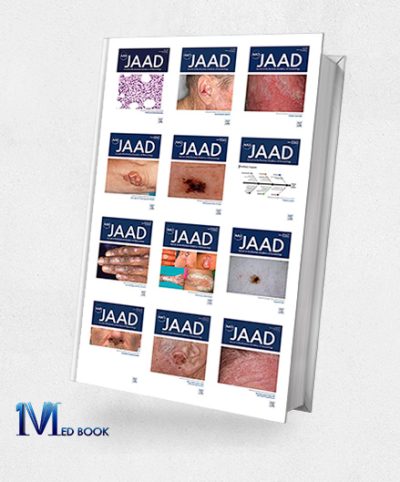Dermatology
Atlas of Clinical Dermatology in Coloured Skin (EPUB)
Original price was: $180.00.$23.00Current price is: $23.00.Botulinum Toxin for Facial Harmony (Original PDF from Publisher)
Original price was: $168.00.$35.00Current price is: $35.00.Dermatologia e malattie sessualmente trasmesse (EPUB)
Original price was: $190.05.$45.00Current price is: $45.00.Dermatopathology 2nd Edition (Original PDF from Publisher)
Original price was: $132.18.$27.10Current price is: $27.10.Dermatopathology A Volume in the High Yield Pathology Series (Original PDF from Publisher)
Original price was: $188.07.$30.30Current price is: $30.30.Diagnostic Atlas of Melanocytic Pathology
Original price was: $200.01.$31.00Current price is: $31.00.Inflammatory Skin Disorders (Demos Surgical Pathology Guides) (Original PDF from Publisher)
Original price was: $72.00.$21.00Current price is: $21.00.Journal Of The American Academy Of Dermatology 2023 Full Archives (True PDF)
Original price was: $220.00.$40.00Current price is: $40.00.Manual de dermatología genital, 4th Edition (EPUB)
Original price was: $129.99.$35.00Current price is: $35.00.Margin Control Surgery of the Skin Concepts Histopathology and Applications (EPUB)
Original price was: $89.00.$30.00Current price is: $30.00.Margin Control Surgery of the Skin Concepts Histopathology and Applications (Original PDF from Publisher)
Original price was: $89.00.$30.00Current price is: $30.00.McKee’s Pathology Of The Skin, 5th Edition (Original PDF From Publisher)
Original price was: $403.62.$45.00Current price is: $45.00.Milady Standard Esthetics Fundamentals, 12th Edition (Original PDF from Publisher)
Original price was: $171.95.$37.00Current price is: $37.00.Milady Standard Nail Technology, 8th Edition (Original PDF from Publisher)
Original price was: $96.95.$32.00Current price is: $32.00.Nevos Tumores Neviformes y Sindromes Nevicos (Spanish Edition) (High Quality Image PDF)
Original price was: $171.00.$45.00Current price is: $45.00.Practical Skin Pathology A Diagnostic Approach (Original PDF from Publisher)
Original price was: $250.13.$33.70Current price is: $33.70.Skin Cancer Prevention A Call to Action
Original price was: $131.46.$25.00Current price is: $25.00.Taylor and Elbuluk’s Color Atlas and Synopsis for Skin of Color (Original PDF from Publisher)
Original price was: $114.05.$50.00Current price is: $50.00.Dermatology
Introduction to Dermatology:
Dermatology, a discipline dedicated to the study and treatment of skin, hair, and nail disorders, plays a pivotal role in the realm of healthcare. The skin, being the body’s largest organ, serves as a protective barrier and reflects an individual’s overall well-being. Dermatology extends beyond cosmetic concerns, delving into the intricate mechanisms that maintain skin health and function. It serves as a crucial diagnostic field, unraveling the complexities of various conditions affecting the skin, from common dermatitis to more intricate autoimmune disorders.
The significance of dermatology lies not only in the aesthetic aspects of skin care but also in its role as a sentinel for underlying health issues. Dermatologists contribute to promoting overall well-being by identifying and addressing a spectrum of skin conditions, fostering preventive measures, and advancing treatment modalities. As we explore the multifaceted landscape of dermatology, it becomes evident that this discipline is not merely about external appearances but is an integral component of holistic healthcare, ensuring the health, vitality, and resilience of our body’s protective covering.
Anatomy and Physiology of the Skin:
Dermatology delves into the intricate anatomy and physiology of the skin, unraveling the complexities of its multifaceted structure and functions. The skin, our body’s largest organ, comprises three primary layers: the epidermis, dermis, and subcutaneous tissue. The epidermis, the outermost layer, serves as a protective barrier, shielding the body from external elements and pathogens. Beneath it lies the dermis, containing blood vessels, nerve endings, and essential structures like sweat glands and hair follicles. The subcutaneous tissue, the deepest layer, provides insulation and houses connective tissues.
The functions of the skin are diverse and crucial to our overall well-being. It regulates body temperature, acts as a sensory organ for touch, pressure, and temperature, and serves as a vital immune defense against infections. Appendages such as hair and nails, while seemingly aesthetic, also play essential roles. Hair provides insulation and protection, while nails serve as protective coverings for fingertips and contribute to fine motor functions.
This complex structure underscores the skin’s remarkable resilience and adaptability. Understanding the anatomy and physiology of the skin is fundamental in dermatology, guiding diagnoses and treatments for a spectrum of conditions. As we unravel the intricacies of this dynamic organ, we gain deeper insights into its role in maintaining skin health and its significance in the broader context of human physiology.
Common Skin Conditions:
Dermatology encounters a spectrum of common skin conditions that impact individuals across various age groups and demographics. Acne, a prevalent condition, is characterized by the formation of pimples, blackheads, and whiteheads, often attributed to factors like hormonal changes, genetics, and environmental influences. Eczema, or atopic dermatitis, manifests as itchy and inflamed skin, with causes including genetic predispositions and environmental triggers.
Psoriasis, an immune-mediated disorder, results in the rapid overproduction of skin cells, leading to red, scaly patches. Dermatitis, encompassing various types such as contact dermatitis and seborrheic dermatitis, involves skin inflammation triggered by irritants or allergens. Symptoms may include redness, itching, and rash.
Understanding the causes, symptoms, and available treatment options for these common skin conditions is essential in dermatology. Treatments range from topical medications and phototherapy for psoriasis to lifestyle modifications and moisturizers for eczema. Dermatologists play a pivotal role in diagnosing these conditions, tailoring treatment plans, and educating patients on effective management strategies. The exploration of these common skin conditions highlights the diverse challenges encountered in dermatology and the importance of a comprehensive approach to address the unique characteristics of each condition.
Diagnostic Techniques in Dermatology:
Dermatology relies on a repertoire of sophisticated diagnostic techniques to ensure precise and accurate identification of various skin disorders. Skin biopsies, a common method, involve the removal of a small tissue sample for microscopic examination. This allows dermatologists to analyze the cellular structure, identifying abnormalities and confirming or ruling out specific conditions.
Dermatoscopy, also known as dermoscopy or chemiluminescence microscopy, involves the use of a handheld device with magnification and light to examine skin lesions. This technique aids in visualizing structures not visible to the naked eye, enhancing diagnostic accuracy for conditions such as melanoma and other pigmented lesions.
Patch testing is employed to identify allergic contact dermatitis by applying small amounts of potential allergens to the skin. The dermatologist observes and analyzes the skin’s reaction to determine specific allergens causing the patient’s dermatitis.
These diagnostic techniques play a crucial role in dermatology, allowing for a nuanced understanding of skin disorders. By combining clinical expertise with these methods, dermatologists can offer precise diagnoses, tailor effective treatment plans, and improve overall patient outcomes. The continuous refinement and integration of diagnostic technologies underscore the dynamic nature of dermatology as it strives for enhanced accuracy in the ever-evolving landscape of skin health.
Cosmetic Dermatology and Procedures:
Cosmetic dermatology encompasses a range of procedures designed to enhance skin appearance and address various cosmetic concerns. Botox injections, a widely performed procedure, involve the injection of botulinum toxin to temporarily paralyze muscles, reducing the appearance of wrinkles and fine lines. This intervention is particularly effective in areas prone to dynamic expressions, such as the forehead and around the eyes.
Chemical peels are another common cosmetic dermatology procedure, involving the application of a chemical solution to exfoliate the skin, leading to the removal of damaged outer layers. This promotes skin renewal, addressing issues like uneven pigmentation, acne scars, and fine lines.
Laser therapy utilizes focused light energy to target specific skin concerns. This versatile technique can address issues ranging from unwanted hair and pigmentation to wrinkles and scars. Laser treatments stimulate collagen production, resulting in improved skin texture and tone.
These cosmetic dermatology procedures, among others, offer patients tailored options to achieve their aesthetic goals. Dermatologists play a pivotal role in assessing individual needs, recommending suitable interventions, and ensuring safe and effective outcomes. As the field of cosmetic dermatology continues to evolve, innovations in procedures contribute to an expanding array of options, allowing individuals to enhance their skin appearance and address cosmetic concerns with confidence.
Pediatric Dermatology:
Pediatric dermatology is a specialized field focused on addressing skin conditions specific to the pediatric population. Common skin conditions affecting children, such as eczema and birthmarks, require unique considerations due to the distinctive nature of pediatric skin and the particular challenges associated with young patients.
Eczema, or atopic dermatitis, is a prevalent skin condition in children, characterized by itchy and inflamed skin. Pediatric dermatologists play a crucial role in diagnosing and managing eczema, tailoring treatment plans to accommodate the developmental stages and sensitivities of pediatric skin.
Birthmarks, including hemangiomas and pigmented lesions, are another area of expertise in pediatric dermatology. These benign skin abnormalities may be present at birth or develop shortly afterward. Pediatric dermatologists employ specialized diagnostic techniques and formulate individualized management strategies, considering the potential impact on a child’s physical and psychological well-being.
Pediatric dermatologists provide specialized care that acknowledges the unique needs of children. Their expertise extends beyond medical treatments to include considerations for a child’s growth, development, and overall well-being. As advocates for the smallest patients, pediatric dermatologists contribute to not only the resolution of dermatological issues but also the holistic health and comfort of children and their families.
Dermatopathology and Skin Cancer:
Dermatopathology plays a pivotal role in the diagnosis of skin cancer, contributing to early detection and effective treatment strategies. Dermatopathologists are specialized pathologists who analyze skin samples to identify malignant cells and provide critical insights into various skin conditions, including skin cancer.
In the context of skin cancer, dermatopathologists examine biopsy specimens obtained from suspicious skin lesions. Through microscopic evaluation, they scrutinize the cellular characteristics, patterns, and structures within the skin tissue. In cases of malignancy, dermatopathologists can identify specific types of skin cancer, such as melanoma, basal cell carcinoma, or squamous cell carcinoma, based on distinct histological features.
The importance of early detection in skin cancer care cannot be overstated. Dermatopathologists play a crucial role in facilitating early diagnosis, which significantly improves the prognosis and treatment outcomes for patients. Timely identification allows for prompt intervention, potentially preventing the spread of cancer and enabling more conservative and effective therapeutic approaches.
In the collaborative landscape of dermatology and pathology, dermatopathologists provide essential information that guides clinicians in developing tailored treatment plans for individuals with skin cancer. Their expertise contributes to a comprehensive understanding of skin lesions, ensuring accurate diagnoses and facilitating optimal patient care in the dynamic realm of dermatopathology and skin cancer management.
Emerging Trends in Dermatology
Dermatology is witnessing transformative advancements that are reshaping the landscape of dermatological care. Emerging trends in the field encompass a spectrum of innovations, each contributing to more accessible, personalized, and technologically driven dermatological services.
Teledermatology stands out as a significant trend, leveraging telecommunication technologies to enable remote dermatological consultations. This approach enhances accessibility, allowing patients to consult with dermatologists from the comfort of their homes. Through virtual platforms, dermatologists can assess skin conditions, provide recommendations, and ensure continuity of care.
Personalized skincare is another noteworthy trend, emphasizing tailored approaches based on individual skin characteristics and needs. Advances in technology enable the formulation of skincare regimens that consider factors such as genetics, lifestyle, and environmental influences. This trend reflects a shift toward more targeted and effective skincare interventions.
Nanotechnology applications have also made a substantial impact on dermatology. The use of nanomaterials in skincare products and treatments allows for precise delivery of therapeutic agents, enhancing their efficacy while minimizing side effects. Nanotechnology holds promise in addressing various dermatological concerns, from targeted drug delivery to advanced imaging techniques.
These emerging trends collectively underscore the dynamic evolution of dermatology. Teledermatology, personalized skincare, and nanotechnology applications are not only enhancing patient experiences but also advancing the effectiveness of dermatological interventions. As these innovations continue to shape the future of dermatological care, the field is poised to deliver more accessible, individualized, and technologically-driven solutions for diverse skin health needs.
Dermatology and Mental Health:
The relationship between dermatology and mental health is intricate, with skin conditions exerting a significant impact on individuals’ mental well-being. Skin disorders can influence not only physical health but also psychosocial aspects, contributing to emotional distress and affecting overall mental health.
Skin conditions such as acne, psoriasis, or vitiligo can make people feel self-conscious and embarrassed and have reduced self-esteem because they are visible. The societal stigma attached to such skin disorders can make things worse by exacerbating the psychological and social challenges that people face, leading to anxiety, depression, or social withdrawal.
Dermatological care is not just about treating the physical symptoms of skin disorders but also takes into account the emotional aspects. Dermatologists often work with mental health professionals to provide comprehensive care that recognizes the interconnected nature of dermatological and psychological well-being. Treatment plans may include psychotherapeutic interventions, support groups, and counseling to address the emotional impact of skin conditions.
Understanding the psychosocial dimensions of dermatological care is essential for fostering holistic well-being. By acknowledging and addressing the emotional aspects of skin disorders, dermatologists contribute to enhanced patient outcomes, promoting not only skin health but also mental resilience and improved quality of life. This holistic approach underscores the importance of recognizing the profound interplay between dermatology and mental health in comprehensive patient care.
Global Dermatological Health:
Global dermatological health encompasses a diverse landscape shaped by the prevalence of skin diseases, disparities in access to dermatological care, and concerted international efforts aimed at promoting skin health on a global scale. Skin diseases affect populations worldwide, with variations in prevalence influenced by factors such as geography, climate, genetics, and socioeconomic conditions.
Disparities in access to dermatological care create challenges, especially in resource-limited regions where healthcare infrastructure may be insufficient. Limited access can exacerbate the burden of skin diseases, leading to delayed diagnoses, inadequate treatment, and increased morbidity.
International efforts play a crucial role in addressing these disparities and promoting dermatological health globally. Collaborative initiatives involve sharing knowledge, resources, and expertise to enhance dermatological care in underserved regions. Educational programs, training initiatives, and telemedicine platforms contribute to improving access and building capacity in regions facing dermatological healthcare challenges.
Promoting dermatological health on a global scale requires a multifaceted approach, incorporating preventive measures, early detection, and accessible treatments. By fostering international collaboration and addressing disparities, the global dermatological health community endeavors to reduce the burden of skin diseases and enhance the well-being of individuals worldwide.
Conclusion:
In conclusion, dermatology emerges as a cornerstone in promoting skin health and overall well-being, playing a crucial role in addressing a myriad of dermatological concerns. This medical specialty goes beyond the surface, recognizing the profound impact that skin conditions can have on individuals’ physical health, mental well-being, and overall quality of life. The interdisciplinary nature of dermatological care underscores its holistic approach, where dermatologists collaborate with professionals across various fields, including psychology, pathology, and public health, to provide comprehensive solutions tailored to individual needs.
The ongoing advancements in dermatology exemplify a commitment to continuous improvement and innovation. From emerging technologies like teledermatology to personalized skincare and nanotechnology applications, the field is evolving to meet the diverse and evolving needs of patients. These advancements not only enhance diagnostic accuracy and treatment efficacy but also contribute to a more patient-centric and accessible dermatological care landscape.
As we navigate the dynamic realm of dermatology, it is evident that the field is not just about addressing skin conditions but about empowering individuals to achieve optimal skin health. By emphasizing prevention, early detection, and personalized interventions, dermatology continues to be at the forefront of healthcare, offering solutions that extend beyond aesthetics and profoundly impact the overall well-being of those seeking dermatological care.






















